[English] 日本語
 Yorodumi
Yorodumi- PDB-6b40: BbRAGL-3'TIR synaptic complex with nicked DNA refined with C2 symmetry -
+ Open data
Open data
- Basic information
Basic information
| Entry | Database: PDB / ID: 6b40 | |||||||||
|---|---|---|---|---|---|---|---|---|---|---|
| Title | BbRAGL-3'TIR synaptic complex with nicked DNA refined with C2 symmetry | |||||||||
 Components Components |
| |||||||||
 Keywords Keywords | RECOMBINATION / DNA transposase / DNA cut and paste transposition / DDE family RNase H fold DNA transposase | |||||||||
| Function / homology |  Function and homology information Function and homology informationV(D)J recombination / RING-type E3 ubiquitin transferase / ubiquitin protein ligase activity / chromatin organization / endonuclease activity / histone binding / sequence-specific DNA binding / Hydrolases; Acting on ester bonds / hydrolase activity / protein homodimerization activity ...V(D)J recombination / RING-type E3 ubiquitin transferase / ubiquitin protein ligase activity / chromatin organization / endonuclease activity / histone binding / sequence-specific DNA binding / Hydrolases; Acting on ester bonds / hydrolase activity / protein homodimerization activity / zinc ion binding / nucleus Similarity search - Function | |||||||||
| Biological species |  | |||||||||
| Method | ELECTRON MICROSCOPY / single particle reconstruction / cryo EM / Resolution: 4.3 Å | |||||||||
 Authors Authors | Zhang, Y. / Cheng, T.C. / Xiong, Y. / Schatz, D.G. | |||||||||
| Funding support |  United States, United States,  Romania, 2items Romania, 2items
| |||||||||
 Citation Citation |  Journal: Nature / Year: 2019 Journal: Nature / Year: 2019Title: Transposon molecular domestication and the evolution of the RAG recombinase. Authors: Yuhang Zhang / Tat Cheung Cheng / Guangrui Huang / Qingyi Lu / Marius D Surleac / Jeffrey D Mandell / Pierre Pontarotti / Andrei J Petrescu / Anlong Xu / Yong Xiong / David G Schatz /     Abstract: Domestication of a transposon (a DNA sequence that can change its position in a genome) to give rise to the RAG1-RAG2 recombinase (RAG) and V(D)J recombination, which produces the diverse repertoire ...Domestication of a transposon (a DNA sequence that can change its position in a genome) to give rise to the RAG1-RAG2 recombinase (RAG) and V(D)J recombination, which produces the diverse repertoire of antibodies and T cell receptors, was a pivotal event in the evolution of the adaptive immune system of jawed vertebrates. The evolutionary adaptations that transformed the ancestral RAG transposase into a RAG recombinase with appropriately regulated DNA cleavage and transposition activities are not understood. Here, beginning with cryo-electron microscopy structures of the amphioxus ProtoRAG transposase (an evolutionary relative of RAG), we identify amino acid residues and domains the acquisition or loss of which underpins the propensity of RAG for coupled cleavage, its preference for asymmetric DNA substrates and its inability to perform transposition in cells. In particular, we identify two adaptations specific to jawed-vertebrates-arginine 848 in RAG1 and an acidic region in RAG2-that together suppress RAG-mediated transposition more than 1,000-fold. Our findings reveal a two-tiered mechanism for the suppression of RAG-mediated transposition, illuminate the evolution of V(D)J recombination and provide insight into the principles that govern the molecular domestication of transposons. | |||||||||
| History |
|
- Structure visualization
Structure visualization
| Movie |
 Movie viewer Movie viewer |
|---|---|
| Structure viewer | Molecule:  Molmil Molmil Jmol/JSmol Jmol/JSmol |
- Downloads & links
Downloads & links
- Download
Download
| PDBx/mmCIF format |  6b40.cif.gz 6b40.cif.gz | 374.4 KB | Display |  PDBx/mmCIF format PDBx/mmCIF format |
|---|---|---|---|---|
| PDB format |  pdb6b40.ent.gz pdb6b40.ent.gz | 277.4 KB | Display |  PDB format PDB format |
| PDBx/mmJSON format |  6b40.json.gz 6b40.json.gz | Tree view |  PDBx/mmJSON format PDBx/mmJSON format | |
| Others |  Other downloads Other downloads |
-Validation report
| Summary document |  6b40_validation.pdf.gz 6b40_validation.pdf.gz | 983.8 KB | Display |  wwPDB validaton report wwPDB validaton report |
|---|---|---|---|---|
| Full document |  6b40_full_validation.pdf.gz 6b40_full_validation.pdf.gz | 1004.7 KB | Display | |
| Data in XML |  6b40_validation.xml.gz 6b40_validation.xml.gz | 55 KB | Display | |
| Data in CIF |  6b40_validation.cif.gz 6b40_validation.cif.gz | 82.6 KB | Display | |
| Arichive directory |  https://data.pdbj.org/pub/pdb/validation_reports/b4/6b40 https://data.pdbj.org/pub/pdb/validation_reports/b4/6b40 ftp://data.pdbj.org/pub/pdb/validation_reports/b4/6b40 ftp://data.pdbj.org/pub/pdb/validation_reports/b4/6b40 | HTTPS FTP |
-Related structure data
| Related structure data |  7046MC  7043C  7044C  7045C M: map data used to model this data C: citing same article ( |
|---|---|
| Similar structure data |
- Links
Links
- Assembly
Assembly
| Deposited unit | 
|
|---|---|
| 1 |
|
- Components
Components
-Protein , 2 types, 4 molecules AEMN
| #1: Protein | Mass: 74440.133 Da / Num. of mol.: 2 Source method: isolated from a genetically manipulated source Source: (gene. exp.)  Gene: RAG1L / Production host:  Homo sapiens (human) / References: UniProt: A0A185KID9 Homo sapiens (human) / References: UniProt: A0A185KID9#5: Protein | Mass: 39509.254 Da / Num. of mol.: 2 Source method: isolated from a genetically manipulated source Source: (gene. exp.)  Gene: RAG2L / Production host:  Homo sapiens (human) / References: UniProt: A0A185KIE0 Homo sapiens (human) / References: UniProt: A0A185KIE0 |
|---|
-DNA chain , 1 types, 2 molecules BF
| #2: DNA chain | Mass: 19218.312 Da / Num. of mol.: 2 / Source method: obtained synthetically Source: (synth.)  |
|---|
-31TIR pre-nicked strand of ... , 2 types, 4 molecules CGDH
| #3: DNA chain | Mass: 14357.206 Da / Num. of mol.: 2 / Source method: obtained synthetically Source: (synth.)  #4: DNA chain | Mass: 4601.971 Da / Num. of mol.: 2 / Source method: obtained synthetically Source: (synth.)  |
|---|
-Non-polymers , 2 types, 4 molecules 


| #6: Chemical | | #7: Chemical | |
|---|
-Experimental details
-Experiment
| Experiment | Method: ELECTRON MICROSCOPY |
|---|---|
| EM experiment | Aggregation state: PARTICLE / 3D reconstruction method: single particle reconstruction |
- Sample preparation
Sample preparation
| Component | Name: BbRAGL-31TIR synaptic complex with nicked DNA / Type: COMPLEX / Entity ID: #1-#5 / Source: RECOMBINANT |
|---|---|
| Molecular weight | Value: 0.35 MDa / Experimental value: NO |
| Source (natural) | Organism:  |
| Source (recombinant) | Organism:  Homo sapiens (human) Homo sapiens (human) |
| Buffer solution | pH: 7.6 |
| Specimen | Conc.: 0.4 mg/ml / Embedding applied: NO / Shadowing applied: NO / Staining applied: NO / Vitrification applied: YES |
| Specimen support | Grid material: COPPER / Grid mesh size: 400 divisions/in. / Grid type: C-flat-1.2/1.3 4C |
| Vitrification | Instrument: FEI VITROBOT MARK III / Cryogen name: ETHANE / Humidity: 100 % / Chamber temperature: 283 K |
- Electron microscopy imaging
Electron microscopy imaging
| Experimental equipment |  Model: Titan Krios / Image courtesy: FEI Company |
|---|---|
| Microscopy | Model: FEI TITAN KRIOS |
| Electron gun | Electron source:  FIELD EMISSION GUN / Accelerating voltage: 300 kV / Illumination mode: FLOOD BEAM FIELD EMISSION GUN / Accelerating voltage: 300 kV / Illumination mode: FLOOD BEAM |
| Electron lens | Mode: BRIGHT FIELD / Nominal magnification: 81000 X / Nominal defocus max: 2500 nm / Nominal defocus min: 1200 nm / Cs: 0.01 mm / Alignment procedure: COMA FREE |
| Specimen holder | Cryogen: NITROGEN / Specimen holder model: FEI TITAN KRIOS AUTOGRID HOLDER |
| Image recording | Average exposure time: 10 sec. / Electron dose: 54 e/Å2 / Detector mode: SUPER-RESOLUTION / Film or detector model: GATAN K2 SUMMIT (4k x 4k) / Num. of grids imaged: 1 / Num. of real images: 4429 |
| EM imaging optics | Energyfilter name: GIF Quantum LS / Energyfilter upper: 20 eV / Energyfilter lower: 0 eV |
| Image scans | Sampling size: 5 µm / Width: 7676 / Height: 7420 / Movie frames/image: 40 / Used frames/image: 3-40 |
- Processing
Processing
| EM software |
| ||||||||||||||||||||||||||||||||||||||||||||||||
|---|---|---|---|---|---|---|---|---|---|---|---|---|---|---|---|---|---|---|---|---|---|---|---|---|---|---|---|---|---|---|---|---|---|---|---|---|---|---|---|---|---|---|---|---|---|---|---|---|---|
| CTF correction | Type: PHASE FLIPPING AND AMPLITUDE CORRECTION | ||||||||||||||||||||||||||||||||||||||||||||||||
| Particle selection | Num. of particles selected: 496221 | ||||||||||||||||||||||||||||||||||||||||||||||||
| Symmetry | Point symmetry: C2 (2 fold cyclic) | ||||||||||||||||||||||||||||||||||||||||||||||||
| 3D reconstruction | Resolution: 4.3 Å / Resolution method: FSC 0.143 CUT-OFF / Num. of particles: 350143 / Algorithm: BACK PROJECTION / Symmetry type: POINT | ||||||||||||||||||||||||||||||||||||||||||||||||
| Atomic model building | Protocol: FLEXIBLE FIT / Space: REAL |
 Movie
Movie Controller
Controller




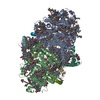
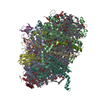

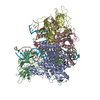
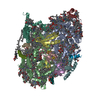
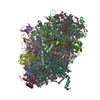
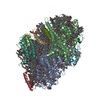
 PDBj
PDBj










































